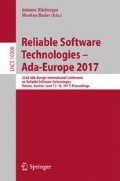Abstract
Coding standards and guidance for secure programming call for sensitive data to be “sanitized” before being de-allocated. This paper considers what this really means in technical terms, why it is actually rather difficult to achieve, and how such a requirement can be realistically implemented and verified, concentrating on the facilities offered by Ada and SPARK. The paper closes with a proposed policy and coding standard that can be applied and adapted to other projects.
Access this chapter
Tax calculation will be finalised at checkout
Purchases are for personal use only
References
CESG. Coding Requirements and Guidance (IA Developers’ Note 6), CESG, Issue 1.1, October 2015. www.ncsc.gov.uk/guidance/coding-requirements-and-guidance-ia-developers-note-6
US CERT. SEI CERT C Coding Standard. www.securecoding.cert.org/confluence/display/c/SEI+CERT+C+Coding+Standard
ISO/SC22/WG23. Information Technology — Programming Languages — Guidance to avoiding vulnerabilities in programming languages through language selection and use. TR 24772 (2013). http://www.open-std.org/JTC1/SC22/WG23/
Mitre Corp. Common Weakness Enumeration (CWE). http://cwe.mitre.org/
Cryptography Coding Standard Project. cryptocoding.net/index.php/Cryptography_Coding_Standard
Aho, A.V., Lam, M.S., Sethi, R., Ullman, J.D.: Compilers: Principles, Techniques and Tools, 2nd edn. Pearson, Upper Saddle River (2013). ISBN 978-1292024349
Percival, C.: Zeroing Buffers is Insufficient. www.daemonology.net/blog/2014-09-06-zeroing-buffers-is-insufficient.html
Programming Langauges – C. ISO/IEC 9899:2011 (2011). http://www.open-std.org/jtc1/sc22/wg14/www/standards.html
Programming Langauges – C++. ISO/IEC 14822:2011 (2011). http://www.open-std.org/JTC1/SC22/WG21/docs/standards.html
Barnes, J.: With Altran Praxis. SPARK: The Proven Approach to High-Integrity Software (2012). ISBN: 978-0-9572905-0-1
McCormick, J.W., Chapin, P.C.: Building High-Integrity Applications with SPARK. Cambridge University Press, Cambridge (2015). ISBN 978-1-107-04073-1
SPARK 2014 Community Site. www.spark-2014.org
Consolidated Ada 2012 Language Reference Manual. ISO/IEC 8652:2012/Cor 1:2016 (2016). www.ada-auth.org/standards/ada12_w_tc1.html
Regehr, J., Eide, E.: Volatiles are miscompiled and what to do about it. In: Proceedings of the Eighth ACM and IEEE International Conference on Embedded Software (EMSOFT), Atlanta, Georgia, October 2008. doi:10.1145/1450058.1450093, www.cs.utah.edu/~regehr/papers/emsoft08-preprint.pdf
Comar, C., Dismukes, G., Gasperoni, F. The GNAT implementation of controlled types. In: Proceedings of Tri-Ada 1994, Baltimore. ACM Press (1994). doi:10.1145/376503.376724
Kirtchev, H.: A new robust and efficient implementation of controlled types in the GNAT compiler. In: Proceedings of High-Integrity Language Technology 2012, ACM SIGAda Letters, vol. 32, issue. 3 pp. 43–50 (2012). doi:10.1145/2402676.2402693
GNAT sources at gcc.gnu.org. gcc.gnu.org/viewcvs/gcc/trunk/gcc/ada/gcc-interface/trans.c
GCC Online Documentation. Chap. 24 – Link Time Optimization. https://gcc.gnu.org/onlinedocs/gccint/LTO.html
LLVM Compiler Infrastructure. Link Time Optimization: Design and Implementation. http://llvm.org/docs/LinkTimeOptimization.html
Leroy, X.: Formal verification of a realistic compiler. Commun. ACM, 52(7), (2009). doi:10.1145/1538788.1538814
Kang, J., Kim, Y., Hur, C-K., Dreyer, D., Vafeiadis, V.: Lightweight verification of separate compilation. In: Proceedings of the 43rd Annual ACM SIGPLAN-SIGACT Symposium on Principles of Programming Languages (POPL) 2016, pp. 178–190. ACM Press. doi:10.1145/2837614.2837642
Acknowledgements
The author would like to thank Robert Seacord, Florian Schanda, Bill Ellis and the conference reviewers for their comments on earlier drafts of this paper.
Author information
Authors and Affiliations
Corresponding author
Editor information
Editors and Affiliations
Rights and permissions
Copyright information
© 2017 Springer International Publishing AG
About this paper
Cite this paper
Chapman, R. (2017). Sanitizing Sensitive Data: How to Get It Right (or at Least Less Wrong…). In: Blieberger, J., Bader, M. (eds) Reliable Software Technologies – Ada-Europe 2017. Ada-Europe 2017. Lecture Notes in Computer Science(), vol 10300. Springer, Cham. https://doi.org/10.1007/978-3-319-60588-3_3
Download citation
DOI: https://doi.org/10.1007/978-3-319-60588-3_3
Published:
Publisher Name: Springer, Cham
Print ISBN: 978-3-319-60587-6
Online ISBN: 978-3-319-60588-3
eBook Packages: Computer ScienceComputer Science (R0)

